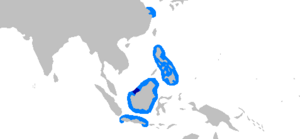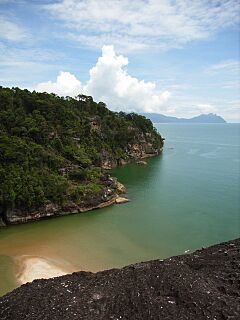Borneo shark facts for kids
Quick facts for kids Borneo shark |
|
|---|---|
 |
|
| Conservation status | |
| Scientific classification | |
| Genus: |
Carcharhinus
|
| Species: |
borneensis
|
 |
|
| Present (dark blue) and possible historical (light blue) range of the Borneo shark | |
| Synonyms | |
|
Carcharias borneensis Bleeker, 1858 |
|
The Borneo shark (Carcharhinus borneensis) is a very rare type of requiem shark. It belongs to the family Carcharhinidae. This shark is known to live in the inshore waters around Mukah in northwestern Borneo. It might have lived in more places in the past.
This small, gray shark can grow up to about 65 centimeters (2 feet) long. It is the only shark in its genus that has a row of special, enlarged pores above the corners of its mouth. The Borneo shark has a thin body, a long, pointed snout, and a small second dorsal fin that is placed behind its anal fin.
Like other requiem sharks, the Borneo shark gives birth to live young. The mother provides food to her pups through a special connection called a placenta. The International Union for Conservation of Nature (IUCN) has listed this species as Critically Endangered. This means it is at a very high risk of disappearing forever. Even though a group of these sharks has been found recently, they still need protection because they live in a small area where a lot of fishing happens.
Contents
Discovering the Borneo Shark
A Dutch scientist named Pieter Bleeker first described the Borneo shark in 1858. He named it Carcharias (Prionodon) borneensis. His description was based on a newborn male shark, about 24 centimeters (9.4 inches) long, caught near Singkawang in western Kalimantan, Borneo. Later, other scientists decided this shark belonged to the group called Carcharhinus.
Before 2004, scientists only knew about five Borneo shark specimens. All of them were young sharks and had been collected before 1937. Then, in April and May 2004, researchers from Universiti Malaysia Sabah found more of these sharks. They discovered them while studying fishery resources in Sabah and Sarawak.
Scientists are still trying to figure out the exact family tree of the Borneo shark. Some features, like the special pores near its mouth, make it look a bit like the sharpnose sharks. However, other parts of its body clearly show it belongs with the Carcharhinus group.
What the Borneo Shark Looks Like
The Borneo shark has a slender body and a long, pointed snout. Its nostrils are slit-like and have small, nipple-shaped flaps of skin in front of them. The shark's eyes are quite large and round, and they have special eyelids called nictitating membranes.
A unique feature of this shark is the row of enlarged pores right above the corners of its mouth. It has 25–26 rows of teeth in its upper jaw and 23–25 rows in its lower jaw. The upper teeth have a single, narrow, slanted point with jagged edges. The lower teeth are similar but are usually thinner and have finer jagged edges. The shark has five pairs of short gill slits.
Its pectoral fins are short, pointed, and shaped like a sickle. The pelvic fins are small and triangular. The first dorsal fin is fairly large and triangular, starting above the tips of the pectoral fins. The second dorsal fin is small and low, beginning over the middle of the anal fin base. There is no ridge between the two dorsal fins. The caudal peduncle (the narrow part before the tail) has a deep, crescent-shaped dip. The caudal fin (tail fin) is uneven, with a well-developed lower part and a longer, narrow upper part.
The shark's skin is covered in small, overlapping scales called dermal denticles. Each scale has three ridges. The Borneo shark is slate-gray on top, and its dorsal fin tips and upper tail fin lobe are darker. Some sharks have small, white spots, which might be from how they were handled. Its underside is white, and this white color extends up its sides as a pale band. The edges of its pectoral, pelvic, and anal fins are faintly lighter. The biggest Borneo shark ever found was about 65 centimeters (2 feet) long.
Where the Borneo Shark Lives
All the recent Borneo shark specimens have been found only at fishing sites in Mukah in Sarawak. This is true even though scientists have searched thoroughly across the rest of Borneo. This suggests that the shark's home range might now be limited to shallow, inshore waters in northwestern Borneo.
Out of the five older specimens, four came from Borneo. One was found near Zhoushan Island in China. This hints that the shark might have lived in a wider area in the past. There were also reports of this species from Borongan in the Philippines in 1895 and Java in 1933. However, these old records cannot be confirmed, and no Borneo sharks have been seen in those areas since.
Reproduction and Diet
Scientists believe that bony fishes are the main food for the Borneo shark. Like other requiem sharks, it is viviparous, which means it gives birth to live young. The developing embryos are fed by the mother through a placental connection that forms from the yolk sac.
A mother Borneo shark usually has a litter of six pups. The pups are born at about 24 to 28 centimeters (9.4 to 11 inches) long. Based on the sharks found, male Borneo sharks likely become mature when they are under 55 to 58 centimeters (21.7 to 22.8 inches) long. Females become mature when they are under 61 to 65 centimeters (24 to 25.6 inches) long.
How Humans Affect the Borneo Shark
The International Union for Conservation of Nature (IUCN) has listed the Borneo shark as Critically Endangered. This is because earlier searches for the shark in its supposed historical range did not find any.
The Borneo shark's future is still uncertain. It lives in a very small area where a lot of small-scale and commercial fishing takes place. Fishermen catch it with lines, and it is used for meat. However, it is not a very important fish for commercial trade.



